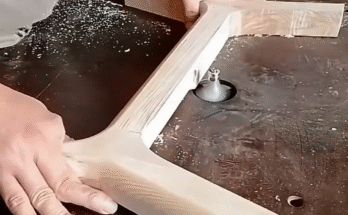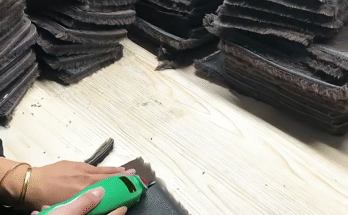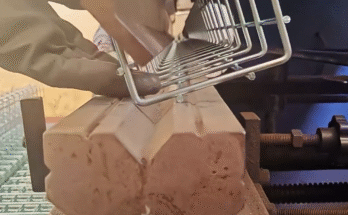Cement permeable bricks are at the forefront of sustainable urban development, offering an innovative solution for managing stormwater and replenishing groundwater. These specialized bricks feature an interconnected void structure that allows water to pass through, mitigating runoff and reducing the strain on drainage systems. Their production is a precise process, balancing material science with manufacturing efficiency to create a durable and eco-friendly building material.
Phase 1: Raw Material Preparation and Proportioning
The foundation of a high-quality permeable brick lies in the meticulous selection and precise measurement of its components.
Step 1: Material Selection
- Cement: The primary binder, typically Ordinary Portland Cement (OPC), is chosen for its binding properties. The quantity is carefully controlled to ensure adequate strength without compromising the brick’s permeability.
- Aggregates: This is the key to permeability. Unlike traditional concrete, permeable bricks utilize a specific grading of coarse aggregates with minimal to no fine aggregates. This creates the essential void network.
- Coarse Aggregates: Crushed stone or gravel, often in a single-sized or open-graded format (e.g., 6mm to 20mm, or specific ASTM D448 designations like No. 8, No. 9, No. 57 stone), is preferred. Angular aggregates generally provide better interlocking and stable void structures than rounded ones.
- Fine Aggregates (Optional/Minimal): Some specialized mix designs may incorporate a very small percentage of coarse sand or stone dust, but the overarching goal is to minimize or eliminate fine aggregates to maximize porosity.
- Water: Clean, potable water is essential for the mix. The water-to-cement (w/c) ratio is kept deliberately low compared to conventional concrete. This “dry” mix consistency is crucial to prevent the cement paste from filling the voids between the aggregates, thereby preserving permeability.
- Admixtures (Optional):
- Plasticizers/Superplasticizers: These chemicals can enhance the workability of the low-water mix, making it easier to mold without adding excess water.
- Supplementary Cementitious Materials (SCMs): Materials like fly ash, silica fume, or Ground Granulated Blast-furnace Slag (GGBS) can be incorporated to improve strength, durability, and sometimes fine-tune the porous structure.
- Color Agents: Pigments can be added to the mix to produce bricks of various colors, enhancing aesthetic appeal.
Step 2: Weigh Batching
- All raw materials – cement, aggregates, water, and any admixtures – are precisely weighed according to a pre-determined mix design. This rigorous batching ensures consistency in the physical and hydraulic properties of every brick produced. The mix design is typically optimized through laboratory testing to achieve the ideal balance between water infiltration capacity and compressive strength.
Phase 2: Mixing and Molding
This phase involves combining the raw materials into a homogeneous mixture and then shaping them into bricks while preserving the critical porous structure.
Step 3: Mixing
- Dry Blending: The dry components (aggregates, cement, and any dry admixtures or pigments) are first loaded into a concrete mixer (e.g., a pan mixer or a forced action mixer). They are thoroughly blended to ensure a uniform distribution of all solid particles.
- Wet Mixing: Water (and any liquid admixtures) is then gradually introduced into the dry mix while the mixer continues to operate. The mixing process continues until a homogeneous, “no-slump” or “low-slump” consistency is achieved. This mix is distinctly drier and more crumbly than conventional concrete, which is vital for maintaining the open void structure necessary for permeability.
Step 4: Molding (Forming)
- The prepared “earth-moist” mix is transferred into a brick molding machine. The formation of the bricks and their porous structure primarily relies on two common techniques:
- Vibration Compaction (Most Common): The mix is fed into molds, and a vibrating table or a hydraulic vibrator is activated. This controlled vibration compacts the material just enough to consolidate it, allowing the coarse aggregates to form a stable skeletal framework with interconnected pores, without fully densifying the mix. The duration and intensity of the vibration are precisely calibrated.
- Hydraulic Pressing: Some advanced manufacturing processes employ high-pressure hydraulic presses to compact the mix within the molds. This method can yield bricks with higher densities and strengths while still maintaining the desired permeability, often used for mass production of standard or interlocking paver shapes.
- The molding machines are designed to produce bricks in specific dimensions and shapes, including those with integrated spacer bars or lugs that ensure consistent gaps when laid, further facilitating water infiltration.
Phase 3: Curing and Finishing
After being molded, the bricks undergo a crucial curing process to gain their full strength and durability.
Step 5: Demolding
- Immediately following the molding process, the freshly formed “green” bricks are carefully demolded. Due to the low water content of the mix, these bricks are typically rigid enough to hold their shape. They are then transferred onto pallets or trays for transport to the curing area.
Step 6: Initial Setting / Rest Period
- The demolded bricks are often placed in a controlled environment, sometimes referred to as a “rest room,” for a short initial setting period (e.g., 12 to 24 hours). This allows the cement to begin its hydration process and the bricks to gain sufficient early strength for subsequent handling without damage.
Step 7: Curing
- Curing is the most vital step for cement-based products, as it allows the cement to fully hydrate and achieve its designed strength and durability. For permeable bricks, this is typically done in a controlled environment:
- Moist Curing: Bricks are kept in a curing room with high humidity, often achieved through continuous misting or water spraying systems, for an extended period, usually ranging from 7 to 28 days. This provides the necessary moisture for the complete hydration of the cement.
- Temperature Control: Curing rooms are often temperature-controlled to optimize the chemical reactions involved in cement hydration, ensuring consistent and optimal strength development.
- Proper curing is paramount not only for achieving the required compressive strength but also for maintaining the integrity and functionality of the brick’s porous structure.
Step 8: Quality Control and Storage
- Upon completion of the curing process, the bricks undergo rigorous quality control checks. These checks typically include verifying dimensions, assessing visual appearance, testing compressive strength, and, most importantly, measuring their water infiltration rate to ensure they meet permeability standards.
- Once approved, the finished cement permeable bricks are stacked, packaged, and stored, ready for distribution and installation in various sustainable paving applications.
This meticulous production process yields cement permeable bricks that are not only robust and aesthetically pleasing but also play a vital role in modern, eco-conscious infrastructure, effectively managing water and fostering greener urban landscapes.



